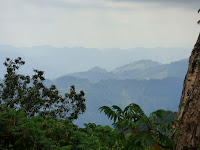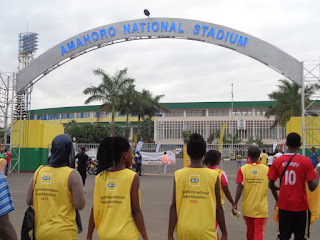This post shares the log book from the second half of our week of vacation in Kenya (July 9 - 17). The first half of our travels is blog post 40.
Wed., July 13 - Landing in Nairobi’s domestic terminal was amazingly simple
compared to international arrivals. It was a short walk on the tarmac from the
plane to the baggage area. Soon we were met by Evelyn and Samson with Lindberg
Safaris. We settled on the price, then explained we needed to have a lunch
before continuing the day’s journey. This landed us at Paul’s Café at the
airport where we enjoyed sandwiches and burgers. After dropping off Everlyn
(she was only part of the pick-up crew), around 2:15pm we were in the van
heading north of Nairobi, west of Mt. Kenya on the scenic drive across several
of Kenya’s major regions and through many tiny towns and two or three large
ones. Samson stopped at Africa’s Curios shop for bathroom and coffee break.
Finally, around 9:15pm we arrived at Thiiri Cultural Center!
Thu., July 14 – we met with Moses Marete, principal of BLISS
at his office around 9am. It was great to have Isaac and Naomi with us to hear
Moses talk about the challenges of being a principal at a school like BLISS.
They may have picked up on the pressures Moses has from parents, students and
the government, and the service-leadership attitude Moses brings to his work,
which has made the school so successful.

Our tour of BLISS included the kitchen (built since RA was
there in 2011) where we deeply inhaled the aromas of cooking porridge and beans
in the giant cookers. We admired the vegetables growing in the greenhouse and
we saw
the cute rabbits (3) in the rabbit hutch. The cornfield had been
plowed, graded and leveled to make way for athletic fields (soccer, volleyball,
basketball) for BLISS students. There had been too many complaints and
complexities with always borrowing the field at neighboring Kithoka Primary
School. Then we saw the new wing on the science lab being built. From there to
the new classroom building, including a peek at the library. We peeked in on 2
Form 1 classes. The music class was small, but math class was very crowded. The
recently drilled well was the final stop on our tour. The idea is to use one
well to supply water for all four schools in the immediate area.

This concluded the BLISS tour so Moses walked us over to
Kithoka Primary. We met Mercy, the school’s senior teacher, but Helen, the new
head teacher was not there. So Mercy showed us around to the teacher’s room,
then the pre-school. Here Naomi and Ruth Ann took turns leading the adorable 3
-4 year olds’ class and 5 – 6 year olds’ class in a brief counting lesson (Ruth
Ann in Swahili, Naomi in English). Then two very bright 5 – 6 year olds lead
the class in a counting lesson in English!
From here we went to briefly visit a 6
th grade class, as that
would be Naomi’s age. They all stood up very respectfully while we told
something about ourselves and where we come from. We pointed out Rwanda on
their map of Africa.
Mercy also proudly showed us their library and their water
purification systems. We said good-bye.
After a quick stop at Thiiri to pick up a picnic lunch we
were on our way with Samson to Samburu National Reserve. That means we headed
north through Isiolo which is a very Muslim town. We ducked into a hotel
restaurant there to see if they might have a suitable snack for Isaac, and I
felt like I was transported to an Indiana Jones movie! The dusty room was
filled with mostly men. The waiter with an Islamic hat (name?) said, “sorry,
chips are finished. We have meat and rice.” And he seemed quite relieved and
satisfied that we decided to leave. Samson took us to the Total gas station
across the street to buy a bag of chips and a Stoney Tanglewizi (ginger ale).
DRIVING TO SAMBURU (still Thu., Jul 14)
On The drive across the desert-like prairie there was
village after village constructed in what we would learn is typical of the
Samburu people. They build a kind a wigwam from sticks and covered with large
leather pieces mixed with plastic pieces, so that some of them even look like a
desert version of an igloo. Many of the homesteads had a rectangular house
built of stone that was held in place by wire mesh. Right next to it would
often be a wigwam style house.
Finally we reached the Samburu gate, paid our fees, and
began the safari. The landscape was beautiful with low mountains on the horizon
always as a backdrop. Right away we saw elephants. Then orynx, zebra, somali
ostrich, Grevy zebra, and gerenuk. Already the “Samburu Big 5”!
Then Samson was suddenly driving very fast, not even pausing
when we spotted our first giraffe. Soon we saw a big group of safari vehicles
including a giant bus, all stopped. Then we spotted it – a leopard lying still
on a fallen tree, right above an elephant eating. Samson brought us around for
a perfect view and we sat in awe (as did all the other tourists) as the leopard
started zeroing in on a dik dik (a tiny antelope-like animal). It didn’t care
at all about the elephant or the dozens of safari vehicles. After the leopard
left, we watched the large group of elephants a bit longer.
Continuing the drive, Samson took us back to track down the
giraffe. We saw more impala, more elephants, Grants gazelles and gerenuk, too.

Naomi was getting bored, tired and hungry(plus she had to use the bathroom.) and we were happy with what we had
seen so we went to the Lion King Bush Camp. Nahim was an amazing Indian-Kenyan
man who has lived in the bush for 20 years. He had two helpers, one younger,
one older, who appeared to be native Samburu people. His son, Nakhil, came
later. They all spoke fluent Samburu and Swahili. The camp itself was a
fantastic bush camp. We had two “luxury tents” with real beds and furniture
inside, hammocks outside over-looking the river, and the most elegant outhouses
I have ever seen! The “dining hall” was an amazingly impressive pavilion built
from trunks of trees that curved up from the ground and were nicely complimented
by curved sofas and low stone walls. The dining room table was the centerpiece
with big wooden chairs with Samburu-looking masks carved on the top of each
one. (Nahim later told us that he and made the roof the same shape as a nearby mountain. And we were all very impressed to see just how similar the two shapes were!)
We enjoyed the campfire they had lighted next to the river
while we drank our Tusker beer and Fanta.
Dinner was a delicious fettuccini and tossed salad, with
fruit for dessert.
Friday, July 15: In the morning, breakfast was omelets, more
fruit along with toast and tea. John made a creative “cone” out of a water bottle to
use with our coffee and coffee filter (since our cone was left at home). We got
going around 7:20 am, only 50 minutes later than planned! (RA really wanted to "get out there"!)
Animals we saw included giraffes (2) and we were excited to
see two cheetahs resting in the shade. One appeared to be just a cub. The most
amazing was - two lionesses stalking waterbuck prey! We also saw many other
waterbuck, two crocodiles, more gerenuk, orynx, elephant and warthogs. The
birds we saw included vulturine guineafowl, spur fowl, hornbills (loved those!)
and a white stork.
Just after exiting the park, Samson took us over to a
village where the Samburu people welcomed visitors “for a donation.” We were
invited inside, which Ruth Ann loved – the rest of the family endured. Of
course, this is where the hard-sell to buy beaded goods was held. But they also
gave us a brief and interesting introduction to the home and their lives.
Besides the 4 of us, there were five Samburu adults and one child in that tiny
hut! The bead-work was beautiful, but pricey, so we only bought one bracelet.
We got back to Meru with time to visit the Kithoka
Polytechnique School. There Wilson gave us a great tour and we were impressed
by many things they are teaching there: cooking, sewing and hair-styling for
the women. Brick making, stone cutting (?), mechanic work and carpentry for the
men. There is substantial work on agriculture there also. They are teaching how
to grow food crops like cabbage, tomato and beans.
Then we stopped at Thiiri Center. We met the bishop,
Florence and Marilyn there. Then Samson took us to Mwanika church. Pastor
Joshua was there and showed us around the new educational wing and the
sanctuary.
Sat., July 16, three
of us had a quick jog around Thiiri’s campus before we left in the morning. We
headed West to Nanyuki and the Ol Pajeta Conservancy. We arrived around 11am.
Within the first 15 minutes John spotted a Rhino off in the distance. That one
walked quickly into the bushes. Later we saw a big Rhino just laying in the
middle of a field, not too far away. We took photos for almost 20 minutes and
it never moved. Samson took us to the Chimp sanctuary, which was more
interesting than I thought with rescued chimpanzees from elsewhere in Africa.
At the end of the drive, we saw a male lion and lioness, slumbering in the
shade of a bush! Fantastic! (except for the fact that we had gone quite a ways off of the road to see them!)
So we ended the
game drive at the spot where you visit Baraka, a blind, rescued rhino who you
can also touch, with the help of a guide who helps you feed the big guy sugar
cane.
We had our late lunch at Marinda Restaurant, which was
perfectly situated with open-air tables, friendly staff, an excellent menu of
burgers, wraps, salads and an espresso machine!
The five hour drive to Nairobi was full of traffic as
expected. We left Ol Pajeto (which means Sweetwaters) around 4pm and arrived at
the airport just after 9:30.
At the airport we had to say good-bye to Samson Lindberg who had become like a part of the family during the last three days of travel. He did a great job enlightening us without making us feel bored or ignorant. Most of all, his personal enjoyment and knowledge of the wonders of Kenya helped each of us appreciate them, too!

















































